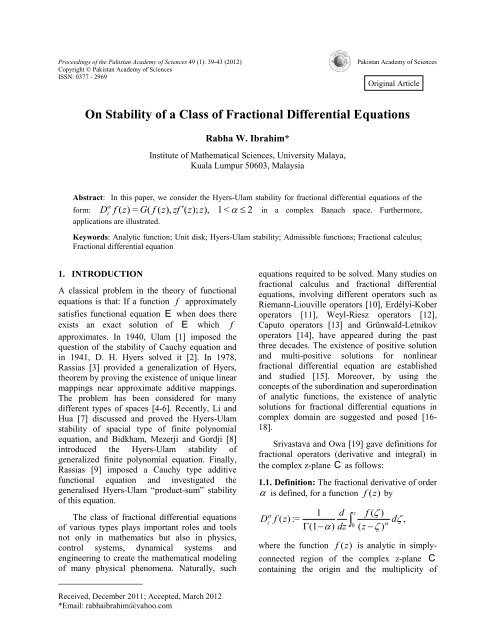TITLE MARCH 2012 - Pakistan Academy of Sciences
TITLE MARCH 2012 - Pakistan Academy of Sciences
TITLE MARCH 2012 - Pakistan Academy of Sciences
You also want an ePaper? Increase the reach of your titles
YUMPU automatically turns print PDFs into web optimized ePapers that Google loves.
Proceedings <strong>of</strong> the <strong>Pakistan</strong> <strong>Academy</strong> <strong>of</strong> <strong>Sciences</strong> 49 (1): 39-43 (<strong>2012</strong>)<br />
Copyright © <strong>Pakistan</strong> <strong>Academy</strong> <strong>of</strong> <strong>Sciences</strong><br />
ISSN: 0377 - 2969<br />
<strong>Pakistan</strong> <strong>Academy</strong> <strong>of</strong> <strong>Sciences</strong><br />
Original Article<br />
On Stability <strong>of</strong> a Class <strong>of</strong> Fractional Differential Equations<br />
Rabha W. Ibrahim*<br />
Institute <strong>of</strong> Mathematical <strong>Sciences</strong>, University Malaya,<br />
Kuala Lumpur 50603, Malaysia<br />
Abstract: In this paper, we consider the Hyers-Ulam stability for fractional differential equations <strong>of</strong> the<br />
<br />
form: D z<br />
f ( z)<br />
= G(<br />
f ( z),<br />
zf (<br />
z);<br />
z),<br />
1< 2 in a complex Banach space. Furthermore,<br />
applications are illustrated.<br />
Keywords: Analytic function; Unit disk; Hyers-Ulam stability; Admissible functions; Fractional calculus;<br />
Fractional differential equation<br />
1. INTRODUCTION<br />
A classical problem in the theory <strong>of</strong> functional<br />
equations is that: If a function f approximately<br />
satisfies functional equation E when does there<br />
exists an exact solution <strong>of</strong> E which f<br />
approximates. In 1940, Ulam [1] imposed the<br />
question <strong>of</strong> the stability <strong>of</strong> Cauchy equation and<br />
in 1941, D. H. Hyers solved it [2]. In 1978,<br />
Rassias [3] provided a generalization <strong>of</strong> Hyers,<br />
theorem by proving the existence <strong>of</strong> unique linear<br />
mappings near approximate additive mappings.<br />
The problem has been considered for many<br />
different types <strong>of</strong> spaces [4-6]. Recently, Li and<br />
Hua [7] discussed and proved the Hyers-Ulam<br />
stability <strong>of</strong> spacial type <strong>of</strong> finite polynomial<br />
equation, and Bidkham, Mezerji and Gordji [8]<br />
introduced the Hyers-Ulam stability <strong>of</strong><br />
generalized finite polynomial equation. Finally,<br />
Rassias [9] imposed a Cauchy type additive<br />
functional equation and investigated the<br />
generalised Hyers-Ulam “product-sum” stability<br />
<strong>of</strong> this equation.<br />
The class <strong>of</strong> fractional differential equations<br />
<strong>of</strong> various types plays important roles and tools<br />
not only in mathematics but also in physics,<br />
control systems, dynamical systems and<br />
engineering to create the mathematical modeling<br />
<strong>of</strong> many physical phenomena. Naturally, such<br />
_____________________<br />
equations required to be solved. Many studies on<br />
fractional calculus and fractional differential<br />
equations, involving different operators such as<br />
Riemann-Liouville operators [10], Erdélyi-Kober<br />
operators [11], Weyl-Riesz operators [12],<br />
Caputo operators [13] and Grünwald-Letnikov<br />
operators [14], have appeared during the past<br />
three decades. The existence <strong>of</strong> positive solution<br />
and multi-positive solutions for nonlinear<br />
fractional differential equation are established<br />
and studied [15]. Moreover, by using the<br />
concepts <strong>of</strong> the subordination and superordination<br />
<strong>of</strong> analytic functions, the existence <strong>of</strong> analytic<br />
solutions for fractional differential equations in<br />
complex domain are suggested and posed [16-<br />
18].<br />
Srivastava and Owa [19] gave definitions for<br />
fractional operators (derivative and integral) in<br />
the complex z-plane C as follows:<br />
1.1. Definition: The fractional derivative <strong>of</strong> order<br />
is defined, for a function f (z)<br />
by<br />
D<br />
<br />
z<br />
1 d<br />
f ( z) :=<br />
(1)<br />
dz<br />
<br />
0<br />
z<br />
f ( )<br />
( z <br />
)<br />
<br />
d<br />
,<br />
where the function f (z)<br />
is analytic in simplyconnected<br />
region <strong>of</strong> the complex z-plane C<br />
containing the origin and the multiplicity <strong>of</strong><br />
Received, December 2011; Accepted, March <strong>2012</strong><br />
*Email: rabhaibrahim@yahoo.com

















